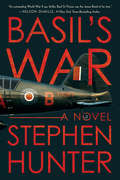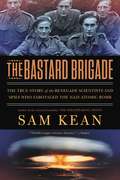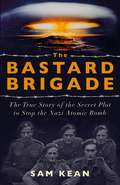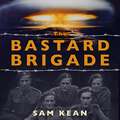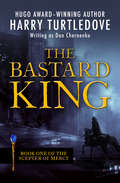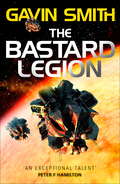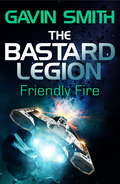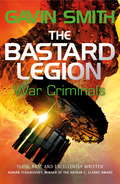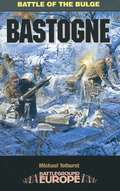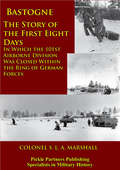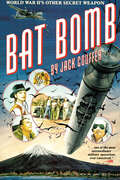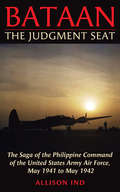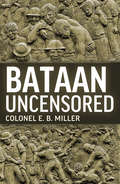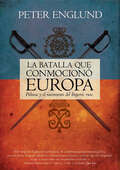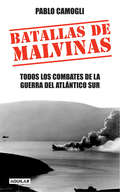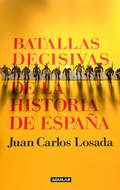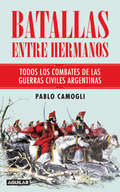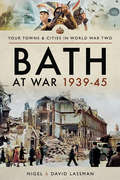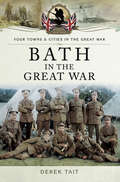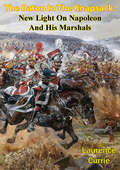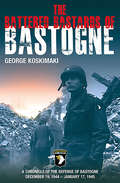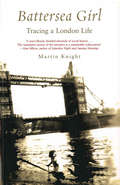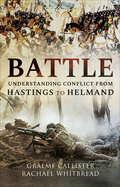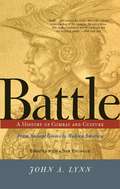- Table View
- List View
Basil's War
by Stephen HunterA swashbuckling British agent goes behind enemy lines to search for a religious text that might hold the key to ending the second World War Basil St. Florian is an accomplished agent in the British Army, tasked with dozens of dangerous missions for crown and country across the globe. But his current mission, going undercover in Nazi-occupied France during World War II, might be his toughest assignment yet. He will be searching for an ecclesiastic manuscript that doesn’t officially exist, one that genius professor Alan Turing believes may hold the key to a code that could prevent the death of millions and possibly even end the war. St. Florian isn’t the classic British special agent with a stiff upper lip—he is a swashbuckling, whisky-drinking cynic and thrill-seeker who resents having to leave Vivien Leigh’s bed to set out on his crucial mission. Despite these proclivities, though, Basil’s Army superiors know he’s the best man for the job, carrying out his espionage with enough charm and quick wit to make any of his subjects lower their guards. Action-packed and bursting with WWII-era intrigue (much of which has basis in fact), Basil’s War is a classic espionage thriller from Pulitzer Prize-winning critic, essayist, and bestselling novelist Stephen Hunter.
The Bastard Brigade: The True Story of the Renegade Scientists and Spies Who Sabotaged the Nazi Atomic Bomb
by Sam KeanFrom New York Times bestselling author Sam Kean comes the gripping, untold story of a renegade group of scientists and spies determined to keep Adolf Hitler from obtaining the ultimate prize: a nuclear bombScientists have always kept secrets. But rarely have the secrets been as vital as they were during World War II. In the middle of building an atomic bomb, the leaders of the Manhattan Project were alarmed to learn that Nazi Germany was far outpacing the Allies in nuclear weapons research. Hitler, with just a few pounds of uranium, would have the capability to reverse the entire D-Day operation and conquer Europe. So they assembled a rough and motley crew of geniuses - dubbed the Alsos Mission - and sent them careening into Axis territory to spy on, sabotage, and even assassinate members of Nazi Germany's feared Uranium Club. The details of the mission rival the finest spy thriller, but what makes this story sing is the incredible cast of characters-both heroes and rogues alike-including: Moe Berg the major league catcher who abandoned the game for a career as a multilingual international spy; the strangest fellow to ever play professional baseball.Werner Heisenberg the Nobel Prize-winning physicist credited as the discoverer of quantum mechanics; a key contributor to the Nazi's atomic bomb project and the primary target of the Alsos mission. Colonel Boris Pash a high school science teacher and veteran of the Russian Revolution who fled the Sovit Union with a deep disdain for Communists and who later led the Alsos mission. Joe Kennedy Jr. the charismatic, thrill-seeking older brother of JFK whose need for adventure led him to volunteer for the most dangerous missions the Navy had to offer. Samuel Goudsmit a washed-up physics prodigy who spent his life huntinh Nazi scientist-and his parents, who had been swept into a concentration camp-across the globe. Irène and Frederic Joliot-Curie a physics Nobel-Prize winning power couple who used their unassuming status as scientists to become active members of the resistance. Thrust into the dark world of international espionage, these scientists and soldiers played a vital and largely untold role in turning back one of the darkest tides in human history.
The Bastard Brigade: The True Story of the Renegade Scientists and Spies Who Sabotaged the Nazi Atomic Bomb
by Sam KeanScientists have always kept secrets. But rarely in history have scientific secrets been as vital as they were during World War II. In the midst of planning the Manhattan Project, the U.S. Office of Strategic Services created a secret offshoot - the Alsos Mission - meant to gather intelligence on and sabotage if necessary, scientific research by the Axis powers. What resulted was a plot worthy of the finest thriller, full of spies, sabotage, and murder. At its heart was the 'Lightning A' team, a group of intrepid soldiers, scientists, and spies - and even a famed baseball player - who were given almost free rein to get themselves embedded within the German scientific community to stop the most terrifying threat of the war: Hitler acquiring an atomic bomb of his very own.While the Manhattan Project and other feats of scientific genius continue to inspire us today, few people know about the international intrigue and double-dealing that accompanied those breakthroughs. Bastard Brigade recounts this forgotten history, fusing a non-fiction spy thriller with some of the most incredible scientific ventures of all time.
The Bastard Brigade: The True Story of the Renegade Scientists and Spies Who Sabotaged the Nazi Atomic Bomb
by Sam KeanNew York Times bestselling author Sam Kean tells the incredible story of how a renegade group of spies kept Hitler from obtaining his ultimate prize: a nuclear bomb.Scientists have always kept secrets. But rarely in history have scientific secrets been as vital as they were during World War II. In the midst of planning the Manhattan Project, the U.S. Office of Strategic Services created a secret offshoot - the Alsos Mission - meant to gather intelligence on and sabotage if necessary, scientific research by the Axis powers. What resulted was a plot worthy of the finest thriller, full of spies, sabotage, and murder. At its heart was the 'Lightning A' team, a group of intrepid soldiers, scientists, and spies - and even a famed baseball player - who were given almost free rein to get themselves embedded within the German scientific community to stop the most terrifying threat of the war: Hitler acquiring an atomic bomb of his very own.While the Manhattan Project and other feats of scientific genius continue to inspire us today, few people know about the international intrigue and double-dealing that accompanied those breakthroughs. Bastard Brigaderecounts this forgotten history, fusing a non-fiction spy thriller with some of the most incredible scientific ventures of all time.(P) 2019 Hachette Book Group Audio Ltd
The Bastard King (The Scepter of Mercy #1)
by Harry TurtledoveTwo rivals must unite to prevent a disgraced malevolent god from attaining a relic of extraordinary power in the first book of alternate history master Harry Turtledove's magnificent fantasy trilogy More than four centuries ago, the Scepter of Mercy was lost to the king of Avornis, and each subsequent liege has promised--and failed--to return the powerful talisman to its rightful home. Now, young Lanius, the only surviving son of King Mergus, rules, though he is considered illegitimate and must abide by the decisions of regents. Still, the legacy of the missing scepter ultimately belongs to him. But it is also coveted by the Banished One, an immortal exiled by the other gods, who invades the world of men through their dreams. Lanius, with no talent or heart for battle, must keep those in the sway of the malevolent deity from Avornis's borders. To this end, Lanius requires the help of Grus, a fearless and respected captain of the king's navy. But Grus has a far loftier destiny than his common birth would suggest--and the bastard king's brave, accomplished ally might well turn out to be his most dangerous adversary. Originally published under the pen name Dan Chernenko, The Bastard King is a magnificent foray into epic fantasy by the incomparable Harry Turtledove, the prolific and multi-award-winning master of alternate history science fiction. A tale of courage and destiny, it is alive with action, imagination, and humanity, and populated by richly complex, imperfect heroes and a villain as truly fiendish as any that has ever graced the fantasy genre.
The Bastard Legion: Book 1 (The Bastard Legion)
by Gavin G. Smith'High octane SF adventure with Smith's trademark twist' Jamie Sawyer'An exceptional talent' Peter F HamiltonFour hundred years in the future, the most dangerous criminals are kept in suspended animation aboard prison ships and "rehabilitated" in a shared virtual reality environment. But Miska Corbin, a thief and hacker with a background in black ops, has stolen one of these ships, the Hangman's Daughter, and made it her own. Controlled by explosive collars and trained in virtual reality by the electronic ghost of a dead marine sergeant, the thieves, gangsters, murderers, and worse are transformed into Miska's own private indentured army: the Bastard Legion. Are the mercenaries just for fun and profit, or does Miska have a hidden purpose connected to her covert past?'Gloriously action-packed and often brutal military SF adventure . . . This series launch will keep readers turning pages, eager to see what bloody adventure awaits and how the legion develops into a force to be reckoned with' Publishers Weekly STARRED REVIEW
The Bastard Legion: Book 2
by Gavin G. Smith'High octane SF adventure with Smith's trademark twist' Jamie Sawyer, author of The Lazarus War'An exceptional talent' Peter F HamiltonIn FRIENDLY FIRE, the Bastard Legion are hired to pull off a daring power-armoured heist of propriety tech. A crime-ridden colony world holds the secret to a potential alien contact, and various groups of mercenaries have been hired to discover it. None of the rest of them have little bombs implanted in their heads, though, so the Bastards have an advantage when it comes to motivation. And Miska, their commander and kidnapper both, is still on the hunt for the people who killed her father. People who might still be among her convicts.Getting the tech will be hard. Getting off the planet, deadly.'a brutal kaleidoscope of imagination' Hannu Rajaniemi, author of The Quantum Thief
The Bastard Legion: Book 3 (The\bastard Legion Ser.)
by Gavin G. SmithDirty, gritty and action-packed adventure featuring the galaxy's deadliest mercenaries, THE BASTARD LEGIONMILITARY SCIENCE FICTION AT ITS BEST. 'High octane SF adventure with Smith's trademark twist' Jamie Sawyer, author of The Lazarus War It was the kind of dirty, violent work the Bastards were made for. Protect a bunch of colonists in the Epsilon Eridani system, whose moon had become a war zone as megacorp-backed mercenaries fought a brutal proxy war. Just the kind of fight the penal mercenary legion liked. But a hundred headless corpses are hard to explain, even for the Bastard Legion, and soon they are on the run, abandoned by their allies, and hunted by their most dangerous foe yet . . . but Miska's going to play them at her own game. The Bastard Legion: the galaxy's most dangerous criminals controlled by implanted explosives and trained by the electronic ghost of a dead marine. 'Gloriously action-packed and often brutal military SF adventure . . .' Publishers Weekly 'An exceptional talent' Peter F HamiltonA 'Dirty Dozen' or 'Suicide Squad' for lovers of 'Aliens', THE BASTARD LEGION series is a down and dirty military SF set in a world of mercenary actions and covert operations.
Bastogne: Battle of the Bulge (Battleground Europe)
by Michael TolhurstBy Christmas 1944, the Allies were on the threshold of victory, having remorselessly rolled the Germans back to the very borders of "The Fatherland". The, the shock of a massive Nazi counter-attack through the Ardennes in the depth of winter threw the Allies into confusion. Bastogne was at the very centre of this dramatic and most dangerous setback.
Bastogne - The Story Of The First Eight Days: In Which The 101st Airborne Division Was Closed Within The Ring Of German Forces [Illustrated Edition]
by S. L. A. Marshall[This edition benefits from numerous maps of the battlefields that the actions were fought over]"NUTS!" - Among the many military legends that abound from the fighting of the Second World War, the one word reply to a German summons to surrender must rank highly in terms of its resonance, importance and sheer grit. General Mcaulliffe decided that despite the odds and the lack of supplies and ammunition his troops would continue to hold the important communication hub of Bastogne during the Battle of the Bulge. This dramatic, yet authoritative account brings all of the action to the fore as the Battered Bastards of Bastogne wrote their names into legend."THIS STORY OF BASTOGNE was written from interviews with nearly all the commanders and staff officers and many of the men who participated in the defense of Bastogne during the first phase of that now celebrated operation--the days during which the American forces were surrounded by forces of the enemy...Thus it is essentially the account of how a single strong defensive force was built from separate commands of armor, airborne infantry and tank destroyers--a force convinced that it could not be beaten."-Introduction.
Bat Bomb: World War II's Other Secret Weapon
by Jack CoufferIt was a crazy way to win World War II in the Pacific— All the United States had to do was to attach small incendiary bombs to millions of bats and release them over Japan's major cities. As the bats went to roost, a million fires would flare up in remote crannies of the wood and paper buildings common throughout Japan. When their cities were reduced to ashes, the Japanese would surely capitulate... The plan made sense to a handful of eccentric promoters and researchers, who convinced top military brass and even President Roosevelt to back the scheme. It might have worked, except that another secret weapon—something to do with atoms—was chosen to end the war. Told here by the youngest member of the team, this is the story of the bat bomb project, or Project X-Ray, as it was officially known. In scenes worthy of a Capra or Hawks comedy, Jack Couffer recounts the unorthodox experiments carried out in the secrecy of Bandera, Texas, Carlsbad, New Mexico, and El Centro, California, in 1942-1943 by "Doc" Adams' private army. This oddball cast of characters included an eccentric inventor, a distinguished Harvard scientist, a biologist with a chip on his shoulder, a movie star, a Texas guano collector, a crusty Marine Corps colonel, a Maine lobster fisherman, an ex-mobster, and a tiger. Not to be defeated by minor logistical hurdles, the bat bomb researchers risked life and limb to explore uncharted bat caves and "recruit" thousands of bats to serve their country. Through months of personality conflicts, military snafus, and technical failures the team pressed on, certain that bats could end the war with Japan. And they might have—in their first airborne test, the bat bombers burned an entire brand-new military airfield to the ground. For everyone who relishes true tales of action and adventure, Bat Bomb is a must-read. Bat enthusiasts will also discover the beginnings of the scientific study of bats.
Bat Bomb: World War II's Other Secret Weapon
by Jack Couffer&“Inside information on a wondrously droll, highly classified yarn from WWII . . . A well-told, stranger-than-fiction tale that could make a terrific movie.&” —Kirkus Reviews The plan: attach small incendiary bombs to millions of bats and release them over Japan&’s major cities. As the bats went to roost, a million fires would flare up in remote crannies of the wood and paper buildings common throughout Japan. When their cities were reduced to ashes, the Japanese would surely capitulate . . . Told here by the youngest member of the team, this is the story of the bat bomb project, or Project X-Ray, as it was officially known. In scenes worthy of a Capra or Hawks comedy, Jack Couffer recounts the unorthodox experiments carried out in the secrecy of Bandera, Texas, Carlsbad, New Mexico, and El Centro, California, in 1942-1943 by &“Doc&” Adams&’ private army. This oddball cast of characters included an eccentric inventor, a distinguished Harvard scientist, a biologist with a chip on his shoulder, a movie star, a Texas guano collector, a crusty Marine Corps colonel, a Maine lobster fisherman, an ex-mobster, and a tiger. The bat bomb researchers risked life and limb to explore uncharted bat caves and &“recruit&” thousands of bats to serve their country, certain that they could end the war with Japan. And they might have—in their first airborne test, the bat bombers burned an entire brand-new military airfield to the ground. For everyone who relishes true tales of action and adventure, Bat Bomb is a must-read. Bat enthusiasts will also discover the beginnings of the scientific study of bats.
Bataan: The Judgment Seat
by Allison IndBataan: the Judgment Seat, first published in 1944 is the account of Lieutenant Colonel Allison Ind about U.S. preparations and defenses prior to and during the Japanese invasion of the Philippines. Ind, an Air Intelligence Officer, provides a blow-by-blow account of his activities within the broader picture of the war, from the tense days before the attack on Pearl Harbor, to the frantic scrambling of unprepared and under-equipped American and Filipino fighting forces, to the defense and fall of Bataan and Corregidor. The book ends with Ind leaving the Philippines via Mindanao for Australia with his commanding officer. Bataan: the Judgment Seat remains a sobering look at America's military in the Pacific during the early days of the Second World War.
Bataan Uncensored
by Col. Ernest MillerBataan Uncensored, published in 1949, is the first-hand account by U.S. Army Colonel Ernest Miller of his experiences in the battle for Bataan, his subsequent surrender and participation in the infamous "Death March," followed by imprisonment at Camps O'Donnell and Cabanatuan, and finally transfer to a labor camp in Japan on a cramped, fetid "Hell Ship." Upon their arrival in the Philippines, Miller, commander of an armored National Guard unit from Minnesota—the 194th Tank Battalion—and his troops are soon thrown into the thick of the fighting in a desperate attempt to slow the Japanese take-over. The U.S. And Philippine armies, grossly unprepared for the massive Japanese invasions, do not have a chance of victory, compounded by their obsolete equipment, lack of fuel and food, and a chaotic command structure. Once in captivity, the struggle to survive begins, hindered by always inadequate food, no medicines to treat raging diseases such as malaria and dysentery, and beatings at the hands of sadistic guards. As the author states, by war's end, 75% of his battalion did not return to the United States. Unlike other works dealing with the U.S. military in the Philippines in the Second World War, Bataan Uncensored realistically portrays the experiences of the soldiers but also identifies critical weaknesses in American policy and tactics that greatly affected the outcome of the battle. Included are 11 pages of maps.
La batalla que conmocionó Europa: Poltava y el nacimiento del Imperio Ruso
by Peter EnglundPoltava y el nacimiento del Imperio Ruso. La batalla de Poltava en 1709 marca el nacimiento del Imperio ruso de Pedro el Grande. En 1700, el zar, de acuerdo con Dinamarca, Sajonia y Polonia, decidió acabar con la hegemonía sueca del norte de Europa. Cuando estas fuerzas internacionales consiguieron derrotar a las tropas del rey Carlos XII en Poltava, Ucrania, empezó el principio del declive y colapso del Imperio sueco y el ascenso de Rusia.Junio de 1709. La guerra dura ya nueve largos años, y el ejército de Carlos XII sitia la ciudad de Poltava, en Ucrania. La caravana a Moscú se ha detenido, y el ejército ruso bajo las órdenes del zar Pedro está solo a cuatro kilómetros de distancia. Los suecos se han estado preparando para la batalla y las tropas, que habían estado desperdigadas por las llanuras de Ucrania, se han congregado. El plan consiste en marchar al amparo de la oscuridad y pillar a los rusos por sorpresa, pero cuando sale el sol todo el plan se desbarata.En este libro se retrata el golpe fatal, hora tras hora, la catástrofe que sesgó 10000 vidas. Se analizan las estrategias en el campo de batalla, los detalles que hacen la historia comprensible, real. A través de los diarios y cartas de los testigos, lo sucedido se llena de las voces de los que estaban allí: el general, sus sirvientes, soldados, el capellán y la viuda de un soldado...
Batallas de Malvinas: Todos los combates de la Guerra del Atlántico Sur
by Pablo CamogliUna obra imprescindible para que la guerra de Malvinas deje de ser una parte silenciada de nuestra historia cercana. ¿Cuál fue el significado de la guerra de Malvinas? ¿Se trató de una lucha justa contra un dominio colonial anacrónico o no fue más que la estrategia de escape de un régimen dictatorial que ya no podía ocultar su crisis? Encontrar las respuestas a estas preguntas no es tarea fácil. La necesidad de pasar de las emociones al juicio objetivo es todavía un desafío pendiente para la sociedad, que, embanderada en la causa desde una u otra posición, llena con ideología los análisis y favorece de ese modo la existencia de ese #manto de neblina# que cubre todavía los sucesos de una guerra cruda, disputada en tierras inhóspitas. Pablo Camogli se propone ayudar a descorrer ese velo mediante la exposición detallada de los hechos bélicos, porque #sin las bombas, sin la muerte, sin el hambre y el frío, ningún análisis estaría completo, ninguna conclusión sería acertada#. Tras una minuciosa investigación, enriquecida con testimonios de los protagonistas, Batallas de Malvinas cuestiona medias verdades y mitos difundidos tras la guerra para favorecer intereses políticos parciales. Revela qué pasó durante esos setenta y cuatro días, con qué capacidad militar se contó y cómo fue utilizada, cuál fue el espíritu de los soldados frente al enemigo, cómo actuaron las Fuerzas Armadas como institución y también de manera individual, sobre todo a la hora del combate, cuál fue el planteo estratégico y con qué tácticas se lo llevó a cabo.
Batallas decisivas de la historia de España
by Juan Carlos LosadaLas grandes batallas que conformaron el futuro de España. Este libro presenta una amena aproximación a los hechos bélicos que marcaron decisivamente el devenir de los acontecimientos en nuestro país. Analizar las batallas, las causas de las mismas, así como las trascendentales consecuencias de sus resultados es el objetivo de esta obra. En ella se analizan pormenorizadamente algunos episodios bélicos fundamentales, desde la Alta Edad Media hasta comienzos del siglo XIX. Juan Carlos Losada trata, por otra parte, de hacer reflexionar al lector sobre lo diferente que podría haber sido la historia de España de no haberse producido estos terribles enfrentamientos, y sobre el papel de la violencia en la construcción de los Estados.
Batallas entre hermanos: Todos los combates de las guerras civiles argentinas
by Pablo CamogliUn recorrido por más de cien años de luchas civiles en el proceso de surgimiento de la nación y la construcción del Estado argentino. «En 1813, una lucha entre dos grupos de guaraníes acabó en un enfrentamiento armado. Los protagonistas nunca lo sabrían, pero este conflicto marcó el inicio de la guerra civil en la Argentina. Sólo 101 años después, esa guerra tendría su conclusión formal.» Este libro recorre esos más de cien años de luchas fratricidas, para develar el papel central que los enfrentamientos armados tuvieron en el surgimiento de la nación y la construcción del Estado argentino. Tanto en la definición del modelo de país como en la delimitación de su territorio, esas guerras civiles no sólo acompañaron la evolución política, sino que en muchos casos la decidieron y determinaron. Con una novedosa y fundamentada interpretación, se incluye la llamada "guerra contra el indio" en el contexto de esas luchas entre hermanos. A partir de una documentada investigación, Pablo Camogli relata las batallas que jalonan esos procesos históricos. Detalla las fuerzas enfrentadas, los recursos de que disponían, los jefes que las comandaban, las tácticas aplicadas, los escenarios donde se produjeron y los resultados de más de cuatrocientos combates, en su correspondiente contexto político, social y económico. Brinda así una visión a la vez integral y pormenorizada de un aspecto central para comprender el surgimiento y la consolidación de la Argentina.
Bath at War, 1939–45 (Your Towns And Cities In World War Two Ser.)
by David Lassman Nigel LassmanBath at War 1939-45 is a comprehensive account of the citys experience of the conflict, covering in detail life on the Home Front set against the background of the wider theatres of war.The narrative of that global struggle is given with a focus on the ordeals endured by the people of Bath, as they cheered their men and women fighters off to war, welcomed thousands of evacuated men, women and children to the city, and faced the full might of Hitlers Luftwaffe.Rare insights into the life of the war-torn city are included, along with untold stories from the footnotes of history, from the Bath blitz to the influx of American GIs. The book incorporates memoirs and memories, along with in depth research from official records and newspaper accounts, so the reader sees the war from the perspective of ordinary people, although the military experiences of Baths citizens - and in many cases their tragic sacrifices - are also included.More controversial topics are also touched upon, such as civil defense, military injustice, racism and local politics, to give a full and fascinating picture of a great city facing profound trials of endurance and courage, thus revealing the many characteristics which has sustained Bath throughout its illustrious history.
Bath in the Great War (Your Towns & Cities in the Great War)
by Derek TaitWhen news of the war broke out in 1914, nothing could prepare the citizens of Bath for the changes that would envelop their city over the next four years. The story of Bath in the Great War is both an interesting and intriguing one. This book covers this historic city's involvement from the commencement of the Great War in July 1914, to the Armistice in November 1918, describing in great detail what happened to the city and its people, including their everyday lives, entertainment, spies and the internment of aliens living within the city. Bath played a key role in the deployment of troops to Northern Europe as well as supplying vital munitions. Local men responded keenly to recruitment drives and thousands of soldiers were billeted in the city before being sent off to fight the enemy overseas. The city also played a vital role caring for the many wounded soldiers who returned home from the front. As the end of the war was announced there were tremendous celebrations in the streets, but the effects of war lasted for years to come. By the end of the conflict, there wasn't a family in Bath who hadn't lost a son, father, nephew, uncle or brother. Bath features many forgotten news stories of the day and includes a considerable collection of rare photographs last seen in newspapers nearly 70 years ago.
The Baton In The Knapsack: New Light On Napoleon And His Marshals
by Laurence CurrieTHE purpose of this book is to sketch briefly the career of Napoleon, especially his relations with his marshals, and to consider how far the marshals were responsible for the rise of the Napoleonic Empire and how some of them at any rate contributed to its fall.It was a saying among the rank and file of the armies of revolutionary France that every soldier carried in his knapsack the bâton of a marshal. This was to prove truer than is usual with such dicta; for more than half of Napoleon's marshals did actually arise from the ranks.In reviewing the period, the student of history can hardly fail to be fascinated by the deeds of valour casting a halo of romance over the entire epoch and to feel that wars productive of so many heroes can hardly have been fought in vain.Mechanical inventions have since degraded the art of war, robbed it of all glamour and added greatly to its horrors. Cavalry charges, such as those which proved decisive at Marengo and at Friedland, are now impossible; but, so long as mankind takes any interest in the past, the story of these mighty contests will always stir the imagination and perhaps excite the envy of future generations.
The Battered Bastards of Bastogne: A Chronicle of the Defense of Bastogne December 19, 1944–January 17, 1945
by George Koskimaki&“Fleshes out in vivid detail the entire story of the Screaming Eagles&’ valiant struggle . . . This is must reading for any student of World War II history&” (Kepler&’s Military History).The Battered Bastards of Bastogne is the product of contributions by 530 soldiers who were on the ground or in the air over Bastogne. They lived and made this history, and much of it is told in their own words. The material contributed by these men of the 101st Airborne Division, the Armor, Tank Destroyer, Army Air Force , and others is tailored meticulously by the author and placed on the historical framework known to most students of the Battle of the Bulge. Pieces of a nearly 60-year-old jigsaw puzzle come together in this book, when memoirs from one soldier fit with those of another unit or group pursuing the battle from another nearby piece of terrain.
Battersea Girl: Tracing a London Life
by Martin KnightA couple of years ago, Martin Knight began a quest to delve into his family history. He had a head start on many amateur genealogists, as 30 years earlier he had produced a school project on the very subject. The project was based on the papers and oral history of his then elderly grandmother, Ellen Tregent. Martin dusted this off and began to assemble the chain of events that shaped his grandmother's life. He even made contact with several living relatives who had known Ellen or some of the people and events she described.Ellen Tregent was born in 1888 and died in 1988 - her lifetime encompassing an unprecedented century of social change and world upheaval. She was born into a poor working-class family in Battersea, London. Her grandfather had arrived from Ireland 40 years earlier to escape almost certain death as potato famine ravaged his country. In Battersea Girl, Martin Knight charts Ellen's long and eventful life and the lives of her siblings. They encounter abject poverty, disease, suicide, murder, war and inevitably death, but, equally, the spirit of stoical people who were determined to make the most of their lives shines through in this enchanting book.
Battle: Understanding Conflict from Hastings to Helmand
by Graeme Callister Rachael WhitbreadWhat are the critical factors that determine the outcome of battles? Which is more decisive in a clash of arms: armies or the societies they represent? How important is the leadership of the commanders, the terrain over which the armies fight, the weapons they use and the supplies they depend on? And what about the rules of war and the strategic thinking and tactics of the time? These are among the questions Graeme Callister and Rachael Whitbread seek to answer as they demonstrate the breadth of factors that need to be taken into account to truly understand battle. Their book traces the evolution of warfare over time, exploring the changing influence of the social, political, technological and physical landscape on the field of battle itself. They examine how the motivation of the combatants and their methods of fighting have changed, and they illustrate their conclusions with vivid, carefully chosen examples from across a range of Western European military history, including the Norman Conquest, the Hundred Years War, the Wars of Religion, the Napoleonic Wars and the world wars, and beyond. By exploring the wide range of interconnected factors that influence the results of battles, the authors broaden the study of this aspect of military history from a narrow focus on isolated episodes of conflict. Their original and thought-provoking writing will be fascinating reading for all students of warfare.
Battle: A History of Combat and Culture
by John A LynnBattle: A History of Combat and Culture spans the globe and the centuries to explore the way ideas shape the conduct of warfare. Drawing its examples from Europe, the Middle East, South Asia, East Asia, and America, John A. Lynn challenges the belief that technology has been the dominant influence on combat from ancient times to the present day. In battle, ideas can be more far more important than bullets or bombs. Carl von Clausewitz proclaimed that war is politics, but even more basically, war is culture. The hard reality of armed conflict is formed by - and, in turn, forms - a culture's values, assumptions, and expectations about fighting. The author examines the relationship between the real and the ideal, arguing that feedback between the two follows certain discernable paths. Battle rejects the currently fashionable notion of a "Western way of warfare" and replaces it with more nuanced concepts of varied and evolving cultural patterns of combat. After considering history, Lynn finally asks how the knowledge gained might illuminate our understanding of the war on terrorism.
